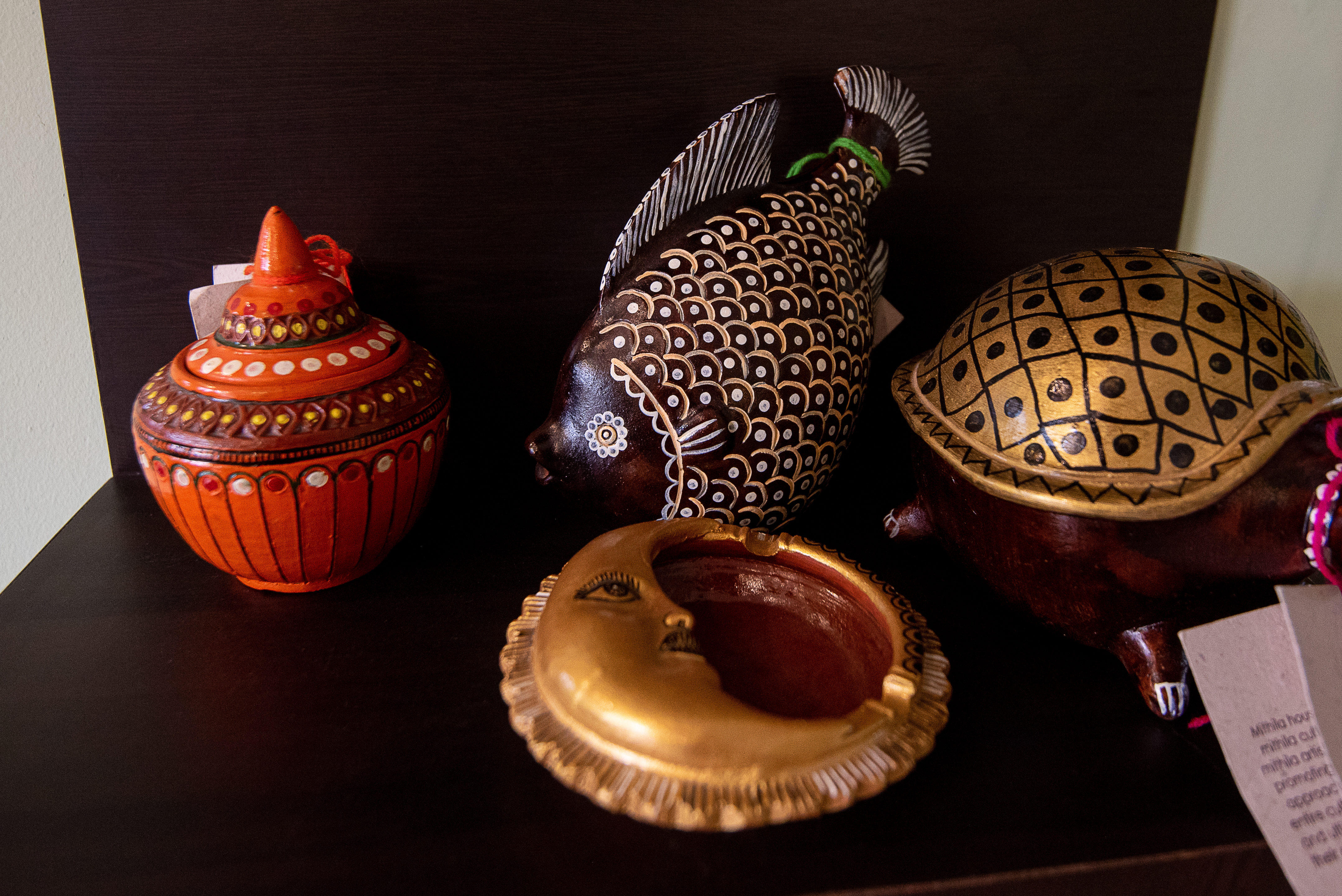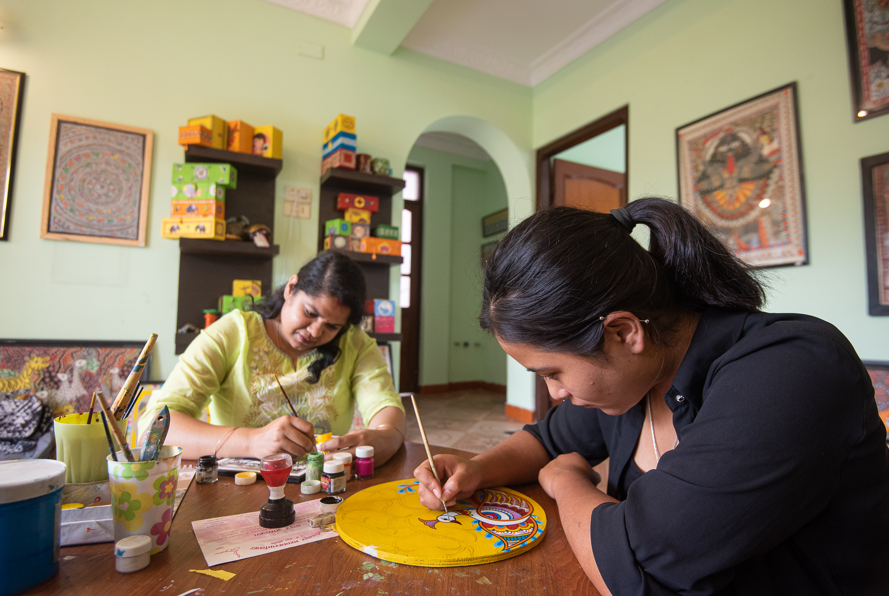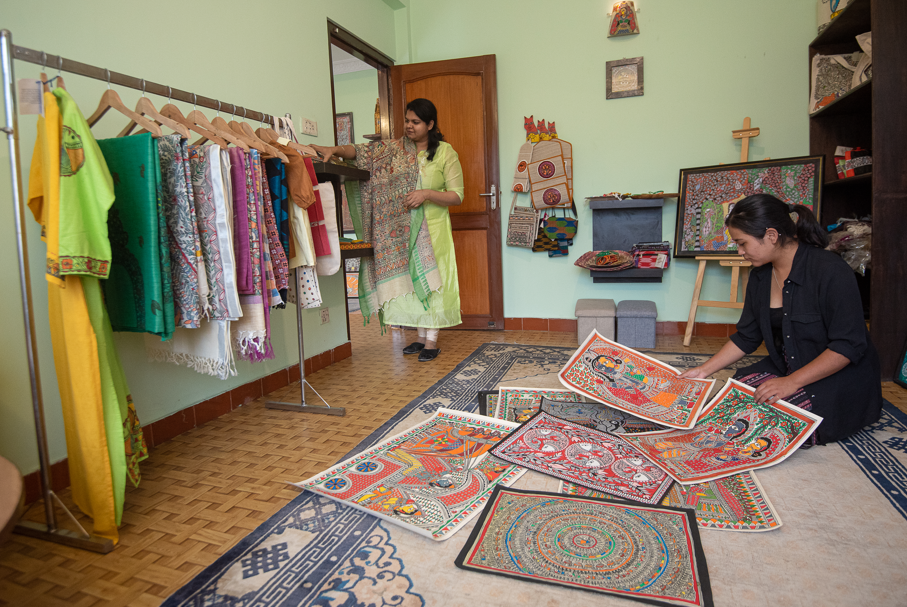The origin of Mithila art is rooted in a legend. King Janak had the walls of homes in his kingdom painted in vibrant color patterns and scenes to welcome Lord Ram when he came to ask for Sita’s hand in marriage. Thereafter, the art was done on walls during weddings and religious festivals, mainly by women, and was passed down generations in the Mithila region—comprising parts of the Indian states of Bihar and Jharkhand and, on Nepal’s side, eastern Tarai. Janakpur, home to the grand white marble structure that is the Janaki Mandir, is popular for Mithila art.
Today, with its one-dimensional portraits, a variety of birds and animals, and other motifs, Mithila art isn’t limited to walls and paper. It has creeped into home décor, clothes, bags, and other accessories—thanks to young entrepreneurs and artists who believe this culturally rich form of art needs to be preserved and promoted.
“I feel the only possible way to do that is by making the art accessible,” says Trishna Singh Bhandari, founder, Mithila House, a social enterprise in Sanepa, Lalitpur. Out of this need came the idea of incorporating Mithila art in just about anything people might use on a regular basis. On display at Mithila House are water bottles, jewelry boxes, kettles, bags, and saris among other things, with intricate Mithila art on them. The main purpose here, adds Bhandari, is a revival of still largely-unknown Mithila art in Nepal. Mithila House intends to do this by making Mithila art a point of conversation.
Mithila art, she says, brings back fond childhood memories and fascinates her. Not only does it have a traditional and cultural background with its depictions of the way of life in Tarai, it has evolved to include stories of women empowerment and that Bhandari finds intriguing and thus worthy of pursuing. Also, Nepali art is mountain and hill centric. There is no representation of Tarai. Mithila art fills that void.
Varsha Jha, a 26-year-old architect, says she is determined to save this art form as it’s close to her heart. Jha grew up in Rajbiraj in the south-eastern part of Province 2 where the walls were always adorned with bright paintings. “I was charmed by all the art I saw around me,” she says. Having always had a penchant for art, Jha decided to teach herself the basics of Mithila art and, in the past five years, she has gone from strength to strength. She now works as a full-time artist at Mithila House. Jha wants to do her masters in Mithila art.
What was once mostly women painting whatever they saw around them has evolved to incorporate so much more. “It’s important to give continuity to that and let it thrive for generations to come,” says Jha. According to Bhandari, the art has international appeal and many companies are exporting Mithila paintings and crafts. Unfortunately, the local art market isn’t as lively. There are people interested in it but it’s still a niche market. One reason for this is that many people don’t understand Mithila art and think it’s juvenile.
“But Mithila art requires a lot of patience and attention to details,” says Sudeshna Maharjan, a 22-year-old fashion designer who is also a self-taught Mithila artist. The techniques of this art form, she adds, is hard to master and takes years of practice. It's not as easy as it looks. It’s a lengthy process—you have to sketch, color, outline and then decorate. Plus, the repetitiveness of designs is time-consuming and the clear separation of patterns, with no room for blending, requires extreme focus and a steady hand. Often, artists are holding their breath while working because a slight out of control movement can cause wobbly lines.
Apart from the fact that Mithila art requires a lot of brain muscle and is labor intensive, what makes it all the more special is that every image has some significance. For instance, peacock stands for love, fish is for purity and fertility, and elephants symbolize friendship. Artist Vaishali Chhetri, 22, says Mithila art is a very diverse genre. While there are strict rules you can’t deviate from, you are free to exercise your creativity and make it as colorful and elaborate as you like.
For her, making Mithila art is meditative because of the various elements she needs to consider while working on a piece. From paint consistency to the pressure on the brush, every aspect requires you to be completely in the present, she says. It takes her four to five days to finish a project. The process is so immersive that she forgets everything else in those days.
Twenty-three-year-old Anisha Das, an engineering student and freelance Mithila artist, says Mithila art is an important part of her culture especially during festivals and weddings. But Das believes such a meaningful art form shouldn’t be limited to special occasions. She grew up watching her aunt paint and when she tried it herself, she couldn’t get enough of it. “I go into a trance when I paint. It’s so soothing,” she says. She wishes people would understand and value this art that is not only visually appealing but documents important stories of women.
Artist Binita Jha, 32, agrees. Mithila art is an identity, she says. It not only connects her to her roots but also keeps her mind agile. After nine years of experience, she has no problem coming up with fresh ideas and even tweaking a painting halfway through when something invariably goes wrong. Like most things traditional and cultural, she says the new generation must take it up to ensure it survives the test of time and the modernization that comes with it.
Chhetri believes a good way to keep Mithila art alive is by incorporating it in our school curriculum. Maharjan thinks online promotions are crucial to reach the masses. Art workshops, on the other hand, can give those who are interested in it a platform to learn. Mithila House has conducted a few in the past and plans to do so in the future too. Bhandari, meanwhile, is focusing on collaborating with other businesses to promote Mithila art. The market, she says, is small, and the only way to grow is through collaborative effort.

Jay Prakash Mandal of ‘Mithila Art Center by Relative Nepal’ says, similar to Mithila House’s objectives, their mission is to increase the visibility of Mithila art by painting it on everyday objects like shopping bags, greeting cards, and jewelry boxes. The organization has also commissioned artists to make Mithila art murals in parts of Kathmandu. The more people see it, the more they will take to it and help keep it alive, he concludes.













